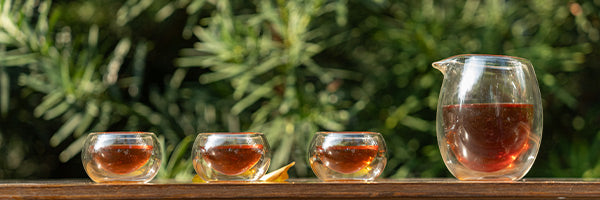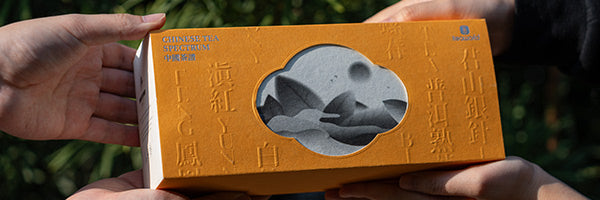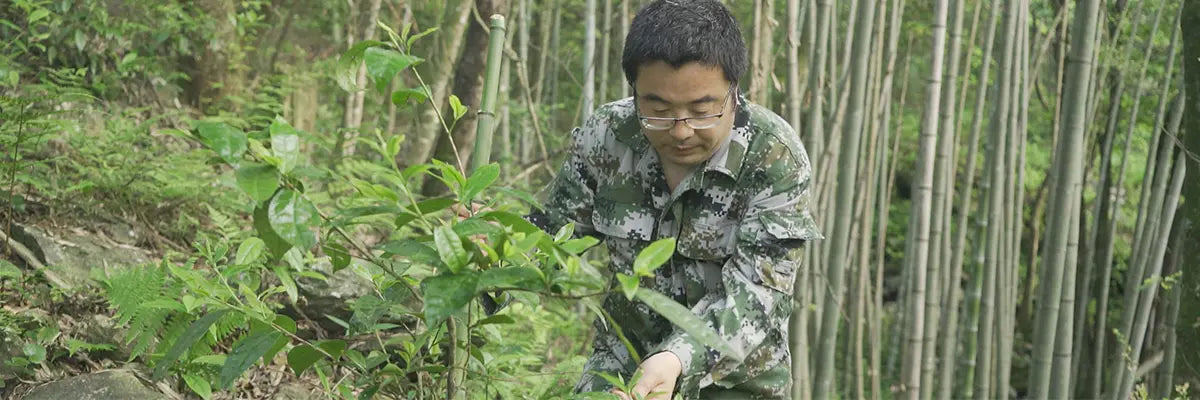Чай Лунцзин часто называют одним из самых известных зеленых чаев Китая. Он приобрел свою репутацию не только благодаря своему уникальному региону выращивания и методам производства, но и благодаря своему освежающему вкусу и отличительному аромату.
В следующих разделах мы углубимся в характеристики, сбор, производство и интригующие исторические истории, связанные с чаем Лунцзин.
Чай Лунцзин имеет долгую историю

Чай Лунцзин, история которого насчитывает более 1200 лет, впервые был описан в «Классике чая», написанной Лу Юем во времена династии Тан.
Среди шести основных категорий листового чая , с которыми мы знакомы, первым появился зеленый чай, и чай Лунцзин можно считать одним из самых ранних сортов зеленого чая, имеющим исключительно долгую и богатую историю.
Четыре уникальности чая Лунцзин
Цвет . Сухие чайные листья имеют яркий, глянцевый изумрудно-зеленый цвет, а чайный настой имеет блестящий, прозрачный, изумрудный оттенок.
Аромат - Чай Лунцзин известен своим свежим и чарующим ароматом, напоминающим орхидею, который часто называют «ароматом каштана».
Вкус - Обладает восхитительным, мягким и освежающим вкусом с естественной сладостью.
Форма - Листья плоские и гладкие, напоминающие "воробьиный язык", с острыми кончиками и изящным видом. Они одинакового размера, как лепестки орхидеи.
Искусство сбора чая Лунцзин

Сбор листьев чая Лунцзин — это скрупулезный процесс, который подчеркивает нежные и цельные листья. Три ключевых принципа сбора урожая — « ранний, нежный и частый ». Традиционно ранний сбор высоко ценится в производстве чая Лунцзин, как говорится в поговорке: «Ранние три дня, лучшие три дня, поздние три дня — просто трава».
Обычно чай Лунцзин лучшего качества собирают непосредственно перед праздником Цинмин, его называют «предцинминским чаем», и он считается лучшим в категории чая Лунцзин.
Чайные листья, собранные до Гую (зернового дождя), известны как «чай до дождя», и они также отличаются высоким качеством, а более поздние урожаи немного менее исключительны.
Процесс производства чая Лунцзин отличается особой тщательностью.
Изготовление зеленого чая в основном включает три основных этапа: Shaqing (уничтожение зеленого) , Rounian (скручивание) и сушка . Эти этапы меньше по сравнению с первичными этапами производства листового черного чая и листового улуна .
Вы можете задаться вопросом, как эти ограниченные шаги могут привести к такому широкому разнообразию зеленого чая в Китае. Фактически, в рамках 3 основных шагов зеленого чая, только на этапе сушки мы можем найти 3 различных метода: сушка на противне, сушка в печи и сушка на солнце.
Чай Лунцзин использует технику сушки на сковороде для сушки, и этот шаг сам по себе является исключительно сложным и подробным. Уникальный процесс обжаривания чая Лунцзин на сковороде включает в себя использование десяти основных движений рук, таких как «захват, встряхивание, подъем, растягивание, нажатие, толкание, подворачивание, щелчок, измельчение и нажатие», что приводит к постоянно меняющейся и действительно впечатляющей операции.
Уникальный климат и географическая среда региона производства чая Лунцзин

Регион производства чая Лунцзин расположен у подножия знаменитого живописного места Цзюйси Шибацзянь, среди гор к западу от Западного озера.
На севере находится туманный Янься-Сандонг, а на юге простираются обширные воды реки Цяньтан. В центральной части возвышается пик Льва, с его низко висящими облаками, создающими живописную картину. Этот регион может похвастаться сложной сетью водных путей с извилистыми ручьями из многочисленных горных долин, которые впадают в реку Цяньтан, появляясь и исчезая на своих извилистых путях.
Окружающие горы перекрывают друг друга, покрытые густыми лесами, а земля имеет уклон с севера на юг. Эта уникальная топография служит как для блокировки холодных северных ветров, так и для захвата теплых южных потоков, что приводит к постоянному савану низкотемпературного тумана над зоной выращивания чая, часто метафорически описываемому как «Девять ручьев и туманных деревьев».
Благоприятная географическая среда, подходящая почва и высококачественные водные источники создают действительно выгодные природные условия для производства чая. Чай Лунцзин известен как «первый чай Китая», и он действительно выигрывает от питательного влияния горных источников и дождей этого региона.
Качество премиального чая Лунцзин
Чай «Чжэцзян Лунцзин» делится на шесть сортов: от высшего до первого, третьего и пятого.
Чай Лунцзин высшего сорта характеризуется ровными, гладкими и прямыми листьями, нежным, глянцевым, светло-зеленым цветом, свежим и тонким ароматом, освежающим и мягким вкусом, а также тонкими и нежными нижними листьями.
Примерно в половине килограмма чая Лунцзин может содержаться до 36 000 чайных почек.
Наслаждение чаем Лунцзин в стеклянной посуде

Использование прозрачной стеклянной чашки при заваривании чая Лунцзин позволит вам наблюдать завораживающий танец чайных листьев в прозрачной воде.
Выбор чайной посуды, хотя и является вопросом личных предпочтений, значительно усиливает визуальные аспекты чайного опыта, где прозрачность чая может успокоить сердце. При заваривании чая Лунцзин вы заметите вертикальные чайные листья, прозрачный и блестящий чайный настой и стойкий, чарующий аромат.
Наслаждение чаем Лунцзин — это двойное наслаждение, как духовное, так и вкусовое. Чтобы испытать это наслаждение, крайне важно приобрести высококачественный чай Лунцзин. Мы приглашаем вас попробовать Green Tea Selections от iTeaworld , среди которых вы найдете высококачественный чай Лунцзин, который вы не должны пропустить.
Чай Лунцзин и история о бегущем тигре. Весна
Су Ши (также известный как Су Дунпо) в своей поэме «Источник бегущего тигра» восхвалял достоинства родниковых вод в Ханчжоу, где он восхвалял чистые и освежающие воды источника Бегущего тигра. Источник Бегущего тигра — один из знаменитых источников Ханчжоу, известный своей чистой и мягкой водой. Заваривание чая Лунцзин с водой из источника Бегущего тигра дает чай с чистым и ароматным вкусом, предлагая опыт, часто описываемый как «Двойное чудо Западного озера».
Чай Лунцзин и история императора Цяньлуна

Во времена династии Цин император Цяньлун совершил шесть походов в Цзяннань, четыре из которых привели его в Лунцзин.
Цяньлун однажды посетил чайные сады Лунцзин, лично собирал чайные листья, наблюдал за фермерами, выращивающими чай, во время процесса сушки и сочинял стихи. Он собрал в общей сложности восемнадцать чайных деревьев, которые тщательно выращивались последующими поколениями и стали известны как «Восемнадцать императорских чайных деревьев». Их ежегодно приносили в дар императорскому двору. Сегодня эти восемнадцать императорских чайных деревьев все еще грациозно стоят возле храма Хугун в окрестностях пика Льва. Цяньлун также написал «Восемь видов Лунцзин» в храме Лунцзин, и по сей день можно найти многочисленные надписи от него, выгравированные на скалах, свидетельствующие о его выдающемся вкладе. Кроме того, он сочинил песню, посвященную чаю Лунцзин.
Вот несколько интересных фактов и историй о чае Лунцзин. Надеюсь, они помогут вам лучше оценить и насладиться этим знаменитым китайским зеленым чаем. Наслаждаясь чаем Лунцзин, я надеюсь, что вы не только насладитесь его уникальным и восхитительным ароматом и вкусом, но и насладитесь сущностью живописных пейзажей Цзяннаня, принимая спокойствие и красоту настоящего момента.
Вам также может понравиться: Чай Лунцзин (Колодец Дракона): руководство по сортам












































































